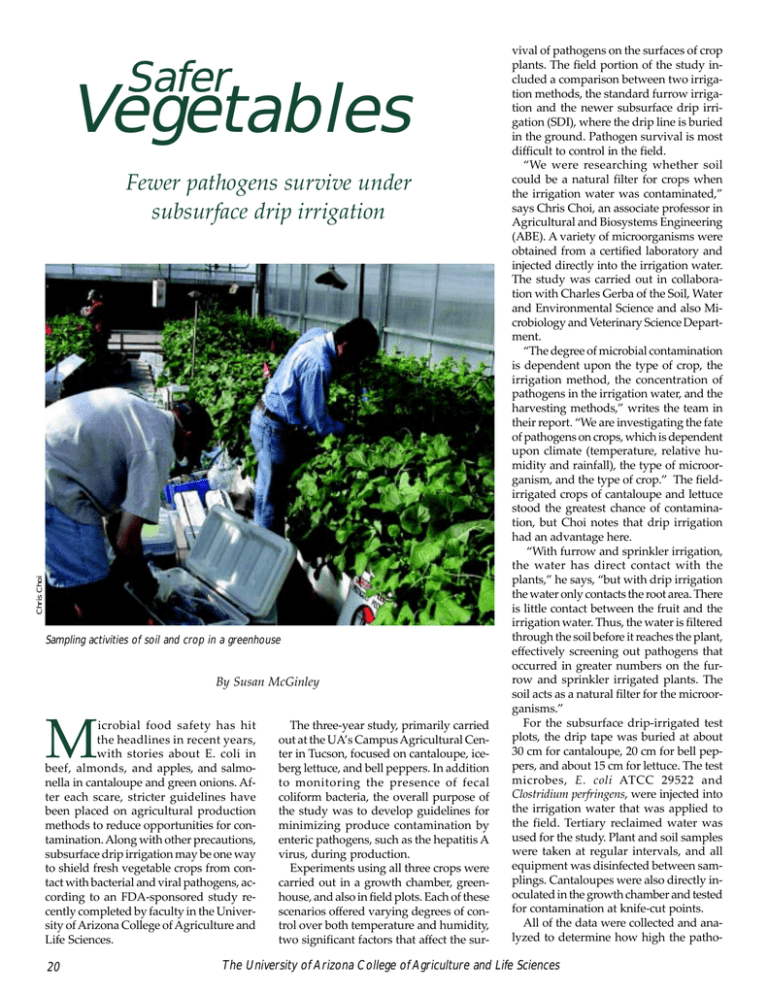Document 10829070
advertisement

Safer Vegetables Chris Choi Fewer pathogens survive under subsurface drip irrigation Sampling activities of soil and crop in a greenhouse By Susan McGinley M icrobial food safety has hit the headlines in recent years, with stories about E. coli in beef, almonds, and apples, and salmonella in cantaloupe and green onions. After each scare, stricter guidelines have been placed on agricultural production methods to reduce opportunities for contamination. Along with other precautions, subsurface drip irrigation may be one way to shield fresh vegetable crops from contact with bacterial and viral pathogens, according to an FDA-sponsored study recently completed by faculty in the University of Arizona College of Agriculture and Life Sciences. 20 The three-year study, primarily carried out at the UA’s Campus Agricultural Center in Tucson, focused on cantaloupe, iceberg lettuce, and bell peppers. In addition to monitoring the presence of fecal coliform bacteria, the overall purpose of the study was to develop guidelines for minimizing produce contamination by enteric pathogens, such as the hepatitis A virus, during production. Experiments using all three crops were carried out in a growth chamber, greenhouse, and also in field plots. Each of these scenarios offered varying degrees of control over both temperature and humidity, two significant factors that affect the sur- vival of pathogens on the surfaces of crop plants. The field portion of the study included a comparison between two irrigation methods, the standard furrow irrigation and the newer subsurface drip irrigation (SDI), where the drip line is buried in the ground. Pathogen survival is most difficult to control in the field. “We were researching whether soil could be a natural filter for crops when the irrigation water was contaminated,” says Chris Choi, an associate professor in Agricultural and Biosystems Engineering (ABE). A variety of microorganisms were obtained from a certified laboratory and injected directly into the irrigation water. The study was carried out in collaboration with Charles Gerba of the Soil, Water and Environmental Science and also Microbiology and Veterinary Science Department. “The degree of microbial contamination is dependent upon the type of crop, the irrigation method, the concentration of pathogens in the irrigation water, and the harvesting methods,” writes the team in their report. “We are investigating the fate of pathogens on crops, which is dependent upon climate (temperature, relative humidity and rainfall), the type of microorganism, and the type of crop.” The fieldirrigated crops of cantaloupe and lettuce stood the greatest chance of contamination, but Choi notes that drip irrigation had an advantage here. “With furrow and sprinkler irrigation, the water has direct contact with the plants,” he says, “but with drip irrigation the water only contacts the root area. There is little contact between the fruit and the irrigation water. Thus, the water is filtered through the soil before it reaches the plant, effectively screening out pathogens that occurred in greater numbers on the furrow and sprinkler irrigated plants. The soil acts as a natural filter for the microorganisms.” For the subsurface drip-irrigated test plots, the drip tape was buried at about 30 cm for cantaloupe, 20 cm for bell peppers, and about 15 cm for lettuce. The test microbes, E. coli ATCC 29522 and Clostridium perfringens, were injected into the irrigation water that was applied to the field. Tertiary reclaimed water was used for the study. Plant and soil samples were taken at regular intervals, and all equipment was disinfected between samplings. Cantaloupes were also directly inoculated in the growth chamber and tested for contamination at knife-cut points. All of the data were collected and analyzed to determine how high the patho- The University of Arizona College of Agriculture and Life Sciences gen concentration needs to be in irrigation water to result in an annual risk of infection from the consumption of contaminated produce. For study purposes, the produce was assumed to be contaminated the day it was irrigated. “We wanted to find out how to avoid contamination, and also how long it would last if it did occur,” Choi says. So far, bell peppers have demonstrated the least amount of contamination because they grow aloft above the ground and have a waxy surface. Cantaloupe tended to retain more microbial contamination than lettuce or bell peppers because they rest on the ground. In addition, it is assumed that the waxy cuticle of the cantaloupe surface is more complex than the surfaces of iceberg lettuce and bell pepper. Therefore, the survival of microorganisms on cantaloupe was greater due to the irregular surface texture and complex cuticle of the fruit. The subsurface drip-irrigated portions of the field experiments resulted in fewer microbes adher- ing to the surface of the fruit. Even for cantaloupe, however, significantly less microbial contamination of both the produce and the soil surface occurred in subsurface drip-irrigated plots as compared to furrow irrigated plots. “Significant numbers of all the microorganisms were recovered from the furrow irrigated plots as compared to the subsurface drip-irrigated plots,” the report states. Cracks did appear in the raised beds, leading to some infection, but plastic mulch might take care of that problem in subsurface plots. Also, Choi recommended that frequent irrigation (adjusted from 20 minutes every hour to 15 minutes every hour and a half) seemed to reduce fruit contamination. “The 10 cm layer of soil likely filtered the E. coli and C. perfringens, because these microorganisms were bigger than the soil pore size,” the team wrote. Of course, many other factors come into play, but generally the microbes that entered the soil through the underground drip line stayed below unless they were turned up through cultivating or cracking. Because microbes tend to survive for a shorter time if they dry out, the researchers recommend that the produce not be harvested and consumed within a few days after the last irrigation or rainfall. The subsurface drip system also improved irrigation water efficiency—less was needed than for the furrow-irrigated crops—and the yields were comparable. “The advantage of doing this in a research situation is that we have all the numbers to show this is doable, and that it can be done in Arizona,” Choi says. CONTACT Chris Choi (520) 621-1890 cchoi@ag.arizona.edu Advantages of Drip-Irrigated Turf Chris Choi • Tennis and croquet court in Phoenix area that has been successfully irrigated with subsurface drip irrigation In southern Arizona’s dry climate, drip irrigation should be a natural choice for watering commercial vegetable crops and turf fields. Yet furrow irrigation still dominates, because it is a more established method, and because drip irrigation is perceived as being more expensive to install and maintain. Although subsurface drip irrigation systems are expensive to install, and do not necessarily result in water savings in turf, unlike in agricultural crops, research conducted at the UA’s Karsten Turf Center for three years shows the following advantages of irrigating turf, according to Chris Choi, associate professor in the UA Department of Agricultural and Biosystems Engineering: Subsurface drip irrigation in turf and other crops reduces groundwater pollution by limiting the amount of fertilizer and pesticide leached into aquifers. • There is no drift due to high winds; no runoff. • No sprinkler heads are exposed, and thus below-ground equipment reduces chances for injury to people playing in parks and schoolyards, and the opportunities for vandalism are reduced. • Buried drip tapes allow more efficient irrigation of irregularly shaped areas, where sprinklers often end up irrigating the sidewalk. • When reclaimed water is distributed below ground, the potential risk of disease caused by bacteria and viruses is greatly reduced. • Weed problems can be reduced. • Subsurface drip irrigation can eliminate rot and watermarks on fences, walls, and sidewalks, a problem normally caused by sprinkler systems. In addition, the subsurface drip system delivers water only where it is needed without creating slippery wet areas on walkways and road surfaces. • Safe and efficient fertilization occurs when fertilizers, added to a single inlet, flow directly to the roots, eliminating waste and avoiding human contact. • Subsurface drip systems require low water pressure, which could reduce power costs. “In the Phoenix area, subsurface drip irrigation has been introduced for urban turf areas,” Choi says.“Some systems have been successfully installed and managed for a decade. In other areas, where people fail to understand or maintain the system, they are very upset. We did this study with one graduate student and it took less effort than maintaining a sprinkler system.” 2004 Agricultural Experiment Station Research Report 21






